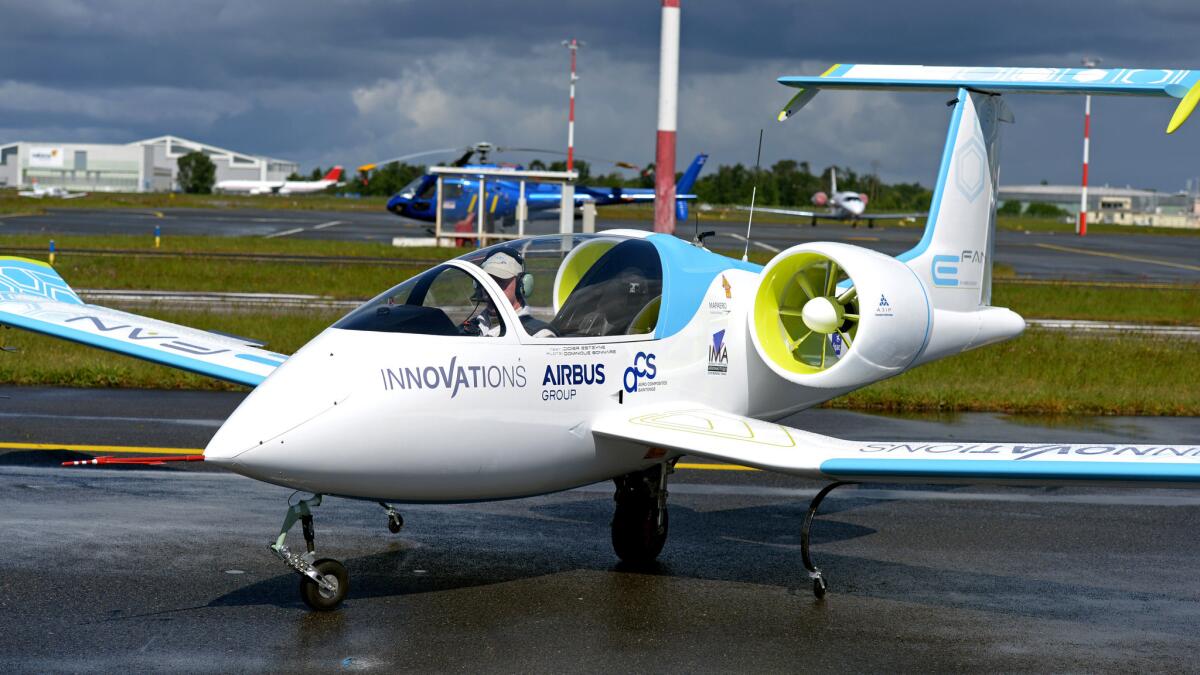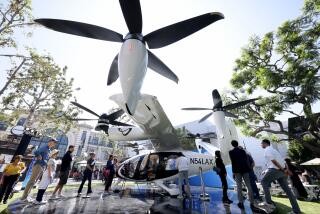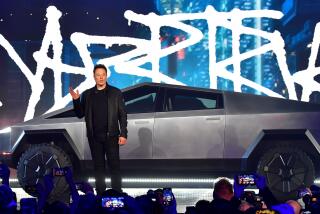No flying Tesla? That’s because electric planes are a steeper challenge than electric cars

Thousands of electric cars are on the road, with many more set to join them over the next few years.
Electric planes? Not so much.
There are several small, experimental aircraft out there — NASA is building an electricity-powered plane set for a test flight next year and a two-seat Airbus electric aircraft soared over the English Channel in 2015. But don’t expect an electric jet to fly hundreds of passengers anytime soon.
Battery limitations all but rule that out.
“A lot of the technical advances that happen start in smaller airplanes,” said Richard Anderson, director of Embry-Riddle Aeronautical University’s flight research center and a professor of aerospace engineering. “There will be a market that stands for smaller, fully-electric airplanes.”
The concept of using electric motors to power airplane systems dates back at least to World War II, when the B-29 Superfortress bomber used electric motors to power its gun turrets.
Since then, other airplanes have replaced the ducts and hoses of hydraulic and pneumatic systems with electrical power to control such things as stabilizers and brakes. That can save significant weight and reduce fuel burn.
Using electrical power to actually propel planes, however, is a more complicated challenge.
In a conventional jet airplane, the engine sucks air in through its front, a compressor squeezes it, and fuel is sprayed in and lit, creating burning gases and forward thrust.
Electric plane power is much simpler — batteries power an electric motor that spins a propeller. It’s more efficient, but involves far less thrust, which is why electric planes tend to be slow.
Airbus’ two-seat electric plane could only go a maximum speed of about 136 miles per hour. A solar-powered plane that completed an around-the-world journey this summer had an average airspeed of 47 miles per hour. The plane, called Solar Impulse 2, had more than 17,000 solar cells that powered four electric motors.
The payoff, however, could be a quieter, greener way to fly.
According to a recent report from the U.S. Environmental Protection Agency, aircraft were responsible for about 8% of the greenhouse gas emitted by the U.S. transportation sector in 2014. That compares to 23% for medium- and heavy-duty trucks and 61% for light-duty vehicles.
“As technology progresses, I think we’ll see big strides in improvements in noise, direct operating costs, reduction in fossil fuel burning and reduction in emissions,” Anderson said of electric aircraft research.
An electric plane gets its energy from batteries, generally lithium-ion. An example of that is NASA’s X-57, an experimental plane that will test how electric propulsion technology can improve performance.
See the most-read stories in Business this hour »
A team of NASA researchers and private industry professionals is converting an Italian-designed Tecnam twin-engine plane fuselage into an all-electric plane by swapping out the original piston engines for electric motors and switching to battery power.
A later iteration of the plane, if it receives funding, would have a modified wing with 14 electric motors that would turn propellers to simulate a high-lift component, which would reduce the speed that’s normally needed to take off.
The conversion is taking place at Scaled Composites’ Mojave headquarters. Prime contractor Empirical Systems Aerospace is from Oceano, Calif.; Electric Power Systems of City of Industry is developing the battery system; Santa Cruz electric aviation start-up Joby Aviation is working on the cruise motors; and San Luis Obispo company Xperimental is making the wing.
The efficiency of electric power enables other design advances, said Sean Clarke, principal investigator for the X-57 project at NASA’s Armstrong Flight Research Center on Edwards Air Force Base. For example, the electric motors’ smaller size and weight allowed engineers to experiment with a smaller wing and multiple engines for increased lift, said Matt Redifer, chief engineer for the X-57.
“I think that electric propulsion technologies are going to greatly improve aircraft design over the next few decades,” Clarke said.
The biggest hurdle for these projects is battery technology, particularly a battery’s specific energy, or the amount of energy it can store for a given amount of weight.
Despite improvements, planes need a lot of lithium-ion batteries to achieve significant range. In electric cars, the main problem was the cost of the batteries, which is starting to come down. In planes, the biggest challenge is weight.
The jet fuel capacity of a Boeing 787 Dreamliner is about 223,000 pounds, according to an airport planning document released in December. The estimated weight of a battery pack with equivalent energy would be 4.5 million pounds, Anderson said.
“Unless there’s a cosmic change in the battery, it’s just not going to work for bigger, faster airplanes,” he said. “It’s going to be a really long time before batteries weigh less than liquid fuel.”
The X-57’s battery system alone weighs about 800 pounds — close to the weight of the plane’s fuselage. The weight of the entire aircraft is 3,000 pounds.
To mitigate this, Empirical Systems Aerospace decided to put the batteries in the fuselage rather than in the wings, said Philip Osterkamp, lead integration engineer for instrumentation systems on the X-57 at Empirical Systems Aerospace.
Packing lithium-ion batteries on a plane has other drawbacks. In 2014, a federal probe found that an internal short circuit in a battery cell was the “probable cause” of a 2013 fire aboard a parked Boeing 787 Dreamliner. Boeing has since redesigned the batteries.
Battery limitations grounded the Firefly, an all-electric helicopter developed several years ago by Sikorsky Innovations as a technology demonstrator. Firefly never flew and the program is no longer active.
“It just wasn’t worth it for where the battery technology was at the time,” said Chris Van Buiten, vice president of innovation at Sikorsky. The company continues “internal explorations and studies” on the technology’s progress, he said.
A more viable solution is a hybrid system with at least two motors: an electric motor that turns the propeller and a gas engine that drives another generator for power.
Since its English Channel crossing, Airbus has modified its all-electric E-Fan into a hybrid to improve range and learn more about that technology. The aerospace giant is also developing an E-Fan 2.0 that runs only on electric power.
NASA considered making its X-57 a hybrid, but because the plane is not intended as a commercial product, the team decided to focus simply on electric propulsion technologies, said Clarke of NASA.
The ideas may not end up working out quite as expected, but he said the plane’s development is “trying to push the limit.”
“NASA’s prepared for that kind of risk,” Clarke said. “We want to take bigger risks and learn where the technology could go.”
Twitter: @smasunaga
MORE BUSINESS NEWS
Elon Musk: Launch pad explosion is ‘most difficult and complex’ failure in SpaceX’s 14 years
Nissan recalls more than 120,000 vehicles after fluid leaks cause fires
ATGATT: All the gear, all the time — even in the dirt
More to Read
Inside the business of entertainment
The Wide Shot brings you news, analysis and insights on everything from streaming wars to production — and what it all means for the future.
You may occasionally receive promotional content from the Los Angeles Times.











